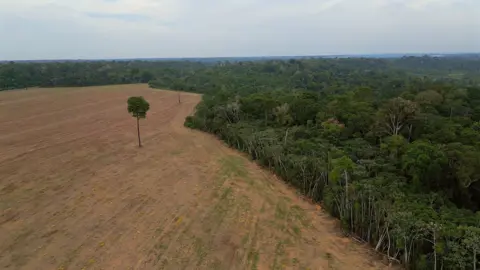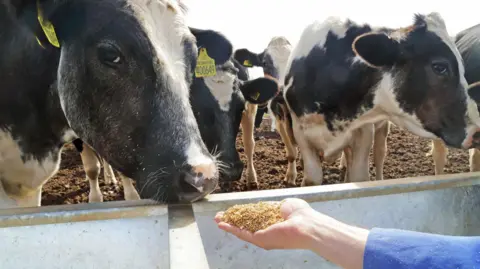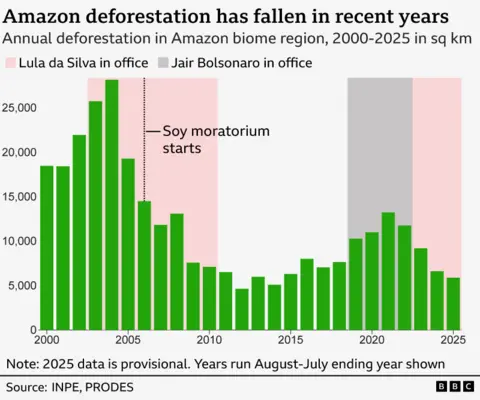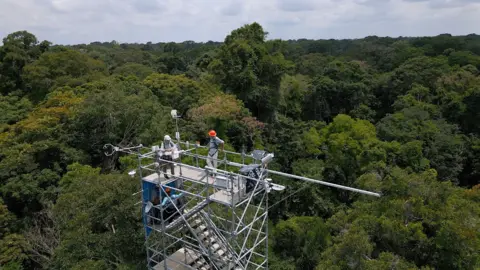Justin Rowlatt,Climate editor and
Jessica Cruz,South America producer
 BBC / Tony Jolliffe
BBC / Tony JolliffeThe Amazon rainforest could face a renewed surge of deforestation as efforts grow to overturn a long-standing ban that has protected it.
The ban – which prohibits the sale of soya grown on land cleared after 2008 – is widely credited with curbing deforestation and has been held up as a global environmental success story.
But powerful farming interests in Brazil, backed by a group of Brazilian politicians, are pushing to lift the restrictions as the COP30 UN climate conference enters its second week.
Critics of the ban say it is an unfair “cartel” which allows a small group of powerful companies to dominate the Amazon’s soya trade.
Environmental groups have warned removing the ban would be “disaster”, opening the way for a new wave of land grabbing to plant more soya in the world’s largest rainforest.
Scientists say ongoing deforestation, combined with the effects of climate change, is already driving the Amazon towards a potential “tipping point” – a threshold beyond which the rainforest can no longer sustain itself.
 Getty Images
Getty ImagesBrazil is the world’s largest producer of soya beans, a staple crop grown for its protein and an important animal feed.
Much of the meat consumed in the UK – including chicken, beef, pork and farmed fish – is raised using feeds that include soya beans, about 10% of which are sourced from the Brazilian Amazon.
Many major UK food companies, including Tesco, Sainsbury’s, M&S, Aldi, Lidl, McDonald’s, Greggs and KFC, are members of a coalition called the UK Soy Manifesto which represents around 60% of the soy imported into the UK.
The group supports the ban, which is known officially as the Amazon Soy Moratorium, because they argue it helps ensure UK soy supply chains remain free from deforestation.
In a statement earlier this year the signatories said: “We urge all actors within the soy supply chain, including governments, financial institutions and agribusinesses to reinforce their commitment to the [ban] and ensure its continuation.”
Public opinion in the UK also appears to be firmly behind protecting the Amazon. A World Wildlife Fund survey conducted earlier this year found that 70% of respondents supported government action to eliminate illegal deforestation from UK supply chains.
 BBC / Tony Jolliffe
BBC / Tony JolliffeBut Brazilian opponents of the agreement last week demanded the Supreme Court – the highest court in the country – reopen an investigation into whether the moratorium amounts to anti-competitive behaviour.
“Our state has lots of room to grow and the soy moratorium is working against this development,” Vanderlei Ataídes told the BBC. He is president of the Soya Farmers Association of Pará state, one of Brazil’s main soya producing areas.
“I don’t understand how [the ban] helps the environment,” he added. “I can’t plant soya beans, but I can use the same land to plant corn, rice, cotton or other crops. Why can’t I plant soya?”
The challenge has even divided the Brazilian government. While the Justice Ministry says there may be evidence of anti-competitive behaviour, both the Ministry of the Environment and the Federal Public Prosecutors Office have publicly defended the moratorium.
The voluntary agreement was first signed almost two decades ago by farmers, environmental organisations and major global food companies, including commodities giants such as Cargill and Bunge.
It followed a campaign by the environmental pressure group Greenpeace that exposed how soya grown on deforested land was being used in animal feed, including for chicken sold by McDonald’s.
The fast-food chain became a champion of the moratorium, whose signatories pledged not to buy soya grown on land deforested after 2008.
Before the moratorium, forest clearance for soya expansion and the growth of cattle ranching were the main drivers of Amazonian deforestation.
After the agreement was introduced forest clearance fell sharply, reaching an historic low in 2012 during President Lula’s second term in office.
Deforestation increased under subsequent administrations – notably under Jair Bolsonaro, who promoted opening the forest to economic development – but has fallen again during Lula’s current presidency.

Bel Lyon, chief advisor for Latin America at the World Wildlife Fund – one of the agreement’s original signatories – warned that suspending the moratorium “would be a disaster for the Amazon, its people, and the world, because it could open up an area the size of Portugal to deforestation”.
Small farmers whose plots are close to soy plantations say they disrupt local weather patterns and make it harder to grow their crops.
 BBC / Tony Jolliffe
BBC / Tony JolliffeRaimundo Barbosa, who farms cassava and fruit near the town of Boa Esperança outside Santarém in the southeastern Amazon, says when the forest is cleared “the environment is destroyed”.
“Where there is forest, it is normal, but when it is gone it just gets hotter and hotter and there is less rain and less water in the rivers,” he told me as we sat in the shade beside the machines he uses to turn his cassava into flour.
The pressure to lift the moratorium comes as Brazil prepares to open a major new railway stretching from its agricultural heartland in the south up into the rainforest.
The railway is expected to significantly cut transport costs for soya and other agricultural products, adding yet another incentive to clear more land.
 BBC / Tony Jolliffe
BBC / Tony JolliffeScientists say deforestation is already reshaping the rainforest in profound ways. Among them is Amazon specialist Bruce Fosberg, who has spent half a century studying the forest.
He climbs 15 stories up a narrow tower that rises 45 metres above a pristine rainforest reserve in the heart of the Amazon. From a small platform at the top, he looks out over a sea of green stretching to the horizon.
The tower is bristling with high-tech instruments – sensors that track almost everything happening between the forest and the atmosphere: water vapor, carbon dioxide, sunlight, and essential nutrients like nitrogen and phosphorus.
The tower was built 27 years ago and is part of a project – the Large-Scale Biosphere-Atmosphere Experiment (LBA) – that aims to understand how the Amazon is changing, and how close it is to a critical threshold.
Data from the LBA together with other scientific studies show parts of the rainforest may be nearing a “tipping point”, after which the ecosystem can no longer maintain its own functions.
“The living forest is closing down,” he says, “and not producing water vapour and therefore rainfall”.
As trees are lost to deforestation, fire, and heat stress, the forest releases less moisture into the atmosphere, he explains, reducing rainfall and intensifying drought. That, in turn, creates a feedback loop that kills even more trees.
The fear is that, if this continues, vast areas of rainforest could die away and become a savannah or dry grassland ecosystem.
Such a collapse would release huge amounts of carbon, disrupt weather patterns across continents, and threaten the millions of people – as well as the countless plant, insect and animal species – whose lives depend on the Amazon for survival.


